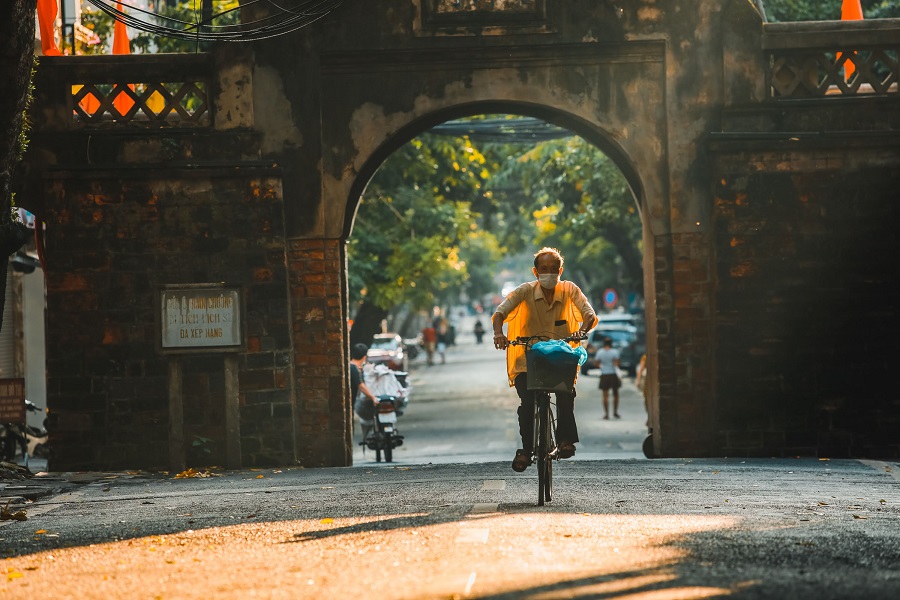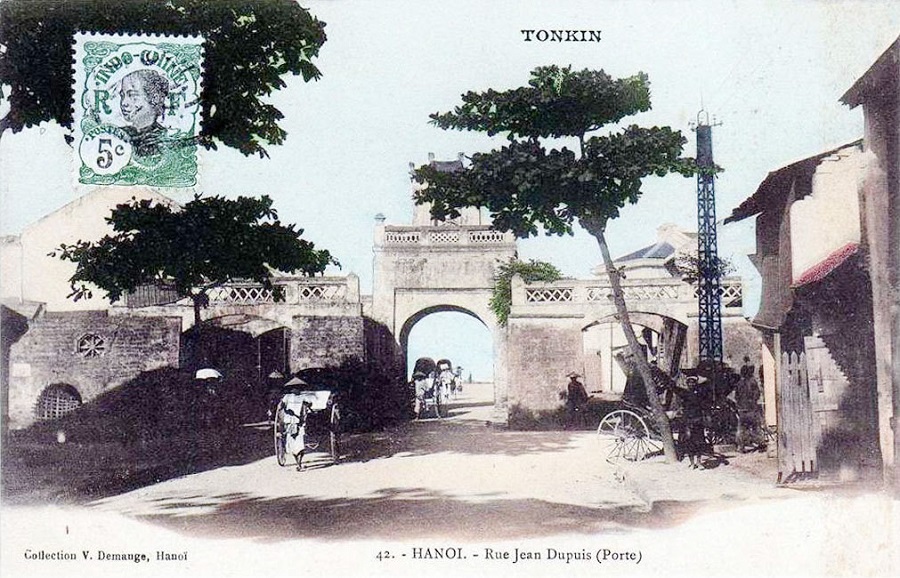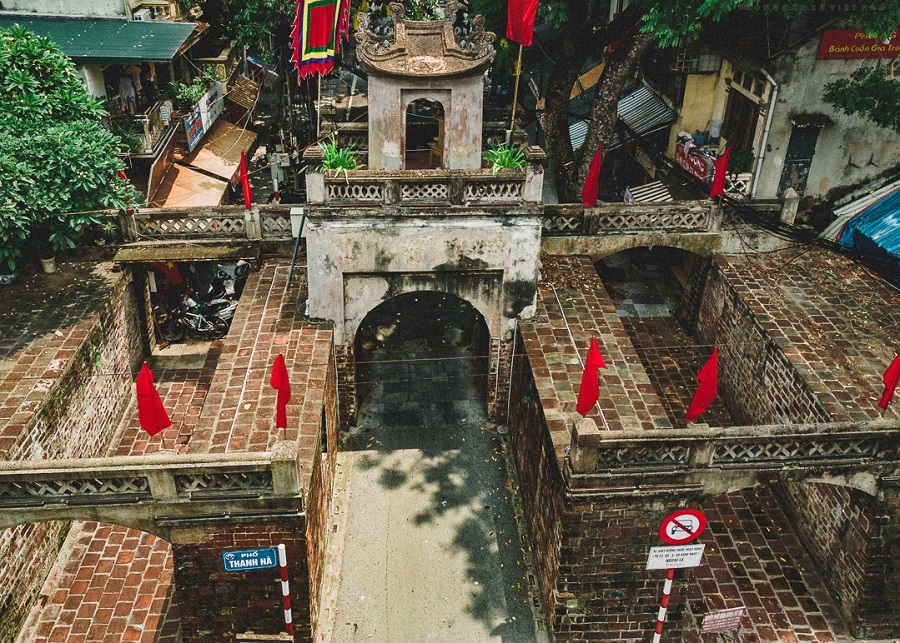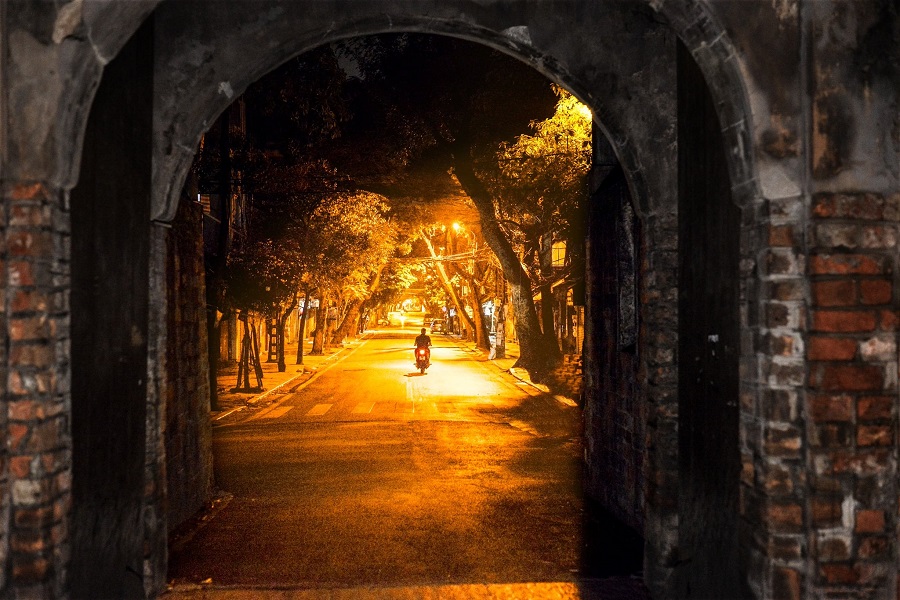City gates are among the typical features of Hanoi’s urban architecture. However, not everyone knows how many city gates there are in the capital, even those who have lived here for a long time.
According to many historical documents and articles in newspapers, it is often said that Hanoi has five gates, but in reality, there were more. Among them, Quan Chuong gate in Hanoi's Old Quarter area is the only ancient gate that still exists nowadays.

The legendary Quan Chuong Gate - the only ancient gate of Hanoi today. Photo: Khanh Huy
An interesting tourist attraction in Hanoi
Located near the bustling Dong Xuan Market in Hang Buom Ward, Hoan Kiem Distritc, Hanoi, the Quan Chuong gate was first built in 1749 under the reign of King Le Hien Tong (1717 - 1786) to protect Thang Long Imperial Citadel.
Through many years of ups and downs, the gate still keeps the ancient and majestic beauty, a pride of the residents. It is one of the attractions of Hanoi, drawing a lot of people to visit, especially on weekends and holidays.
Every day, the bustling life goes on under the gate. Vehicles and people pass through its stone-paved floor day by day, creating a picture of the combination of the past and the present of Hanoi that impresses many visitors.
When visiting Quan Chuong Gate, The Hanoi Times suggests you stop for a while, talking to Ta Van Nhan, 75, who has looked after this only ancient gate of Hanoi for over 20 years. Since then, every day from 6am to 6pm, Nhan cleans the gate and area around it, preventing street vendors and others from using it for their personal purpose.

Ta Van Nhan, 75, looks after the Quang Chuong Gate for over two decades. Photo: Gia Doan/ A Family
It’s not an exaggeration to say that the antiquity and firmness of the gate are preserved thanks to his contribution. Born and raised in a house that is only about 50 meters from the gate, the old man believes that his bond with it is a destiny.
Witnessing a lot of upheavals in Hanoi over the years, Nhan said that Quan Chuong gate still looks the same as it was when he was a child and he wants to contribute to preserving it.
Travelers to the place should also try Mrs.Van’s flat rice noodle soup with beef, which is located at No.6 O Quan Chuong Street, or cold rice stick noodles with a snail at the nearby corner of Dao Duy Tu and Hang Chieu Streets.
For fans of Hanoi-style donuts, the tiny 15-year- old shop, which is located on Hang Chieu Street, near Quan Chuong Gate is a dining option not to be missed. The food store is always packed with locals and travelers who wish to try the “authentic” specialties of Hanoi.
O Quan Chuong’s donut is considered one of the best snack shops in town. The donut here is a bit bigger than your thumb but extremely delicious. Visit the store before 6 pm, otherwise, you will be left with nothing to eat!
Along with Quan Chuong Gate, the tiny food stores around this historic site are always considered a favorite tourist destination of many visitors to Hanoi.
A pride of Hanoians

The Quan Chuong Gate in the old days. File Photo
According to historian Le Van Lan, in the 10th year of Canh Hung (1749), Quan Chuong City Gate was built in the eastern wall of the earthen citadel surrounding the old Thang Long capital area, with the Sino-Vietnamese name Dong Ha Mon (meaning Dong Ha Gate - the gate in former Dong Ha Ward). It has been restored twice, in the 3rd and 16th years of King Gia Long’s reign (1804 and 1817); however, the current architecture is the result of the first repair.
“This gate is called Quan Chuong to commemorate the merits and sacrifice of the officer (Quan) Chuong Co, a guard commander from Bac Ninh. Along with about 100 soldiers of the Nguyen Dynasty, he heroically fought against the French army when they attacked the Hanoi Citadel for the first time (1873) through Dong Ha Gate,” he said.
In terms of design, the gate is also a gazebo - a typical architectural style of the Nguyen Dynasty. Its front faces east towards the Red River, marking the beginning of O Quan Chuong Street, or Rue des Nattes en Joncs Street during the French colonial period. This was the center of the trade of sedge mats - a product of the coastal provinces such as Ninh Binh, Thai Binh, and Nam Dinh, which was brought to Thang Long-Hanoi by waterways. Meanwhile, its back faces west and Hang Chieu Street.
The structure includes two floors. The lower one is a three-arched door. The one in the middle is about three meters high and wide, and the ones on the two sides are about 1.65m wide and 2.5m high.
Above the main door is a gazebo right in the middle, with a four-sided roof and surrounded by balustrades decorated with hexagons, tetragons, and flower shapes. Guards used the gazebo as the watch tower.
Between the middle door and the gazebo is a rectangular frame nearly one meter high and about three meters wide, with three embossed Chinese characters made of blue porcelain on the front: "門河東" (Dong Ha Gate).
From August 2009 to January 4, 2011, Hanoi preserved Quan Chuong City Gate thanks to the US Ambassadors Fund for Cultural Preservation, with a budget of USD74,500. Before the renovation, the relic had been seriously degraded, with cracks in the masonry as well as bulges of up to 30cm.
The walls had also been weathered, mossy, and decayed, with many burnt-clay bricks replaced with solid bricks or fire bricks in previous restorations. On top of that, the traffic system and urban infrastructure here had adversely affected the stability of the structure.
According to Hanoi-based historian Le Van Lan, O Quan Chuong has been a part of the life of many people in Hanoi. “It is also a historical relic where a military unit of the Nguyen Dynasty fought the first French attack on the city in 1873 through Dong Ha gate. Then the gate was renamed as Quan Chuong to commemorate the merit and sacrifice of the military official who led the gate defense,” he stated.

The unique architecture of the Quan Chuong Gate. Photo: VNA
How many gates does Hanoi actually have?
“Five city gates to welcome / As the army approaches…” - those are the words in the triumphant song “Marching towards Hanoi” by late composer Van Cao. The historical song has been spread across the country, so many people think that their capital has only five city gates, while according to historians, there used to be a great number of such gates in ancient walled Hanoi.
According to the “Northern Region Geography Book” compiled in the early 19th century, Hanoi had 21 city gates, yet it did not provide the full list of their names. When King Minh Mang established the “Province of Hanoi” in 1831, the “provincial capital” area (i.e. “inner city”) was immediately mapped.
On the map drawn by Le Duc Loc and Nguyen Cong Tien at that time, the names (in Chinese characters) of 16 gates, together with their locations, are clearly written: Yen Hoa, Yen Tinh, Thach Khoi, Phuc Lam, Dong Ha, Trung Thanh, My Loc, Dong Yen, Tay Luong, Nhan Hoa, Thinh Lang, Yen Ninh, Kim Hoa, Thinh Quang, Thanh Bao and Thuy Chuong. However, there were only 15 gates on the map “Provincial capital of Hanoi”, drawn in 1866 under King Tu Duc’s reign.

The Quan Chuong Gate by night. Photo: Aki Cong
During the period, the gates were the city entrances, with watch towers and checkpoints for controlling access and departure, tax collection, theft, and fire prevention. They were named after the local villages and cantons.
Over time, the old gateways were torn down and streets were built, while their names as we know them today no longer carry the original meaning: Quan Chuong or formerly Thanh Ha in today Hanoi’s downtown, Dong Mac in Lang Yen Street, Cau Den in Thinh Yen Street, Dong Lam in former Kim Lien Ward- Dong Da District, and Cho Dua in Thinh Hao Street.
The only one that remains almost intact is Quan Chuong Gate, which is located at O Quan Chuong Street, near the famous Dong Xuan Market.
Today, Quan Chuong Gate is a favorite tourist destination of locals as well as foreign visitors to the capital city.
The only remaining gate of Hanoi has become a witness of history. It is not only a trace of the ancient Thang Long citadel but also shows the people's indomitable spirit in the fight against foreign invaders to protect the capital city.